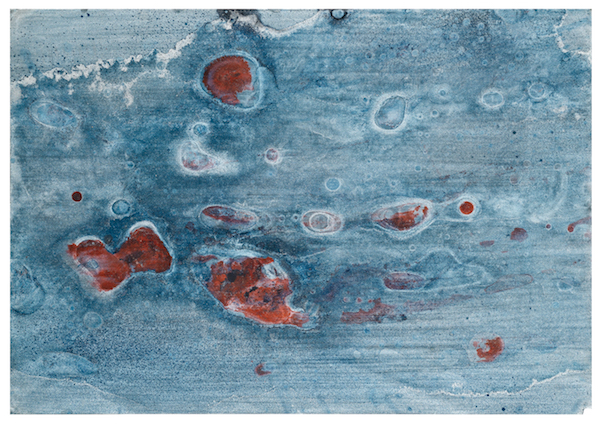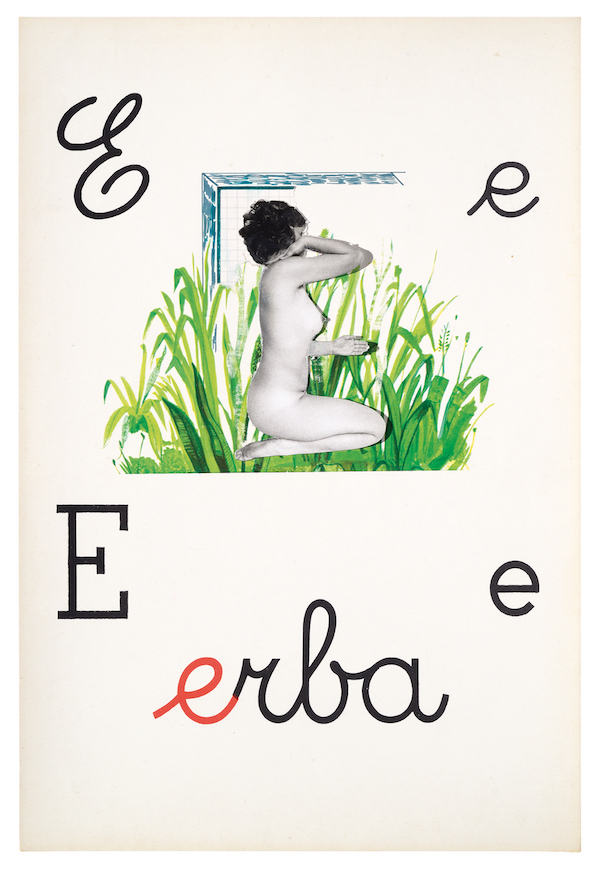Who’s Afraid of Drawing? Works on Paper from the Ramo Collection, Estorick Collection review - surprising and rewarding | reviews, news & interviews
Who’s Afraid of Drawing? Works on Paper from the Ramo Collection, Estorick Collection review - surprising and rewarding
Who’s Afraid of Drawing? Works on Paper from the Ramo Collection, Estorick Collection review - surprising and rewarding
Getting up close to the skin of an artist's thinking

Paper is traditionally the medium though which artists think. Stray thoughts and experiments can be quickly tried out, pushed further or jettisoned. There are no penalties for starting something which goes wrong or transforms into something else because material is cheap, expendable. Erasure or high finish are equally likely, dead ends and new directions begin in the same place.
 Who’s Afraid of Drawing is the second exhibition of around 60 works from the Ramo Collection, which itself comprises some 600 works on paper by 20th century Italian artists. Many of the artists included in the collection — Burri, Tancredi, Fontana (I vigliacchi (Pratelli, Sironi, Ponti), 1933, pictured right) — are better known for their paintings or sculptures; but as Irina Zucca Alessandrelli, curator at the Ramo Collection notes, the purpose of the collection is not to collect famous works or typical pieces but rather to track artists' progression throughout their careers, to get as close to the skin of artists’ thinking as possible — to see them “naked”.
Who’s Afraid of Drawing is the second exhibition of around 60 works from the Ramo Collection, which itself comprises some 600 works on paper by 20th century Italian artists. Many of the artists included in the collection — Burri, Tancredi, Fontana (I vigliacchi (Pratelli, Sironi, Ponti), 1933, pictured right) — are better known for their paintings or sculptures; but as Irina Zucca Alessandrelli, curator at the Ramo Collection notes, the purpose of the collection is not to collect famous works or typical pieces but rather to track artists' progression throughout their careers, to get as close to the skin of artists’ thinking as possible — to see them “naked”.
It is no surprise then that the Estorick Collection’s show throws up some unexpected pieces. Pino Pascali, for instance, is represented by an almost iridescent tempura wash on cardboard stippled with bitumen and petrol, Untitled (Muffa), 1959 (pictured below). Patches of variegated of blue seem to swirl round rust-red clouds, attracted to their movement like storms on Jupiter or amoeba thrashing and replicating in vitro. At first glance it seems quite different to his large, irreverent sculptures — a mere coloured background, an expendable experiment. But the sensation of simultaneously seeing micro- and macroscopically builds to a kind of childish wonder where logic unmoors in favour of dreams. In this sense it’s clearly related to the bold insistence his sculptures make at reconfiguring space and meaning, the impetus is merely translated. The medium can also yield some deeply personal insights. In Untitled (Superficie blu), 1967 by Enrico Castellani, dark paper is stippled with impressions made by pressing it over nail-studded wood. It’s the same technique by which he made his large, textured canvases, but on a smaller scale and with an easier medium. While the physical demands of manipulating the canvas this way eventually became impossible as he aged, he was able to work with paper right up to his death. A halo of yellow spray paint, almost unique in his work, traces an idea considered and then rejected. It’s a redundancy which simultaneously indicates his openness to new techniques and materials while implying the other artists with whom he was in contact at the time. The physicality of the man and the milieu in which he was working are there to be read.
The medium can also yield some deeply personal insights. In Untitled (Superficie blu), 1967 by Enrico Castellani, dark paper is stippled with impressions made by pressing it over nail-studded wood. It’s the same technique by which he made his large, textured canvases, but on a smaller scale and with an easier medium. While the physical demands of manipulating the canvas this way eventually became impossible as he aged, he was able to work with paper right up to his death. A halo of yellow spray paint, almost unique in his work, traces an idea considered and then rejected. It’s a redundancy which simultaneously indicates his openness to new techniques and materials while implying the other artists with whom he was in contact at the time. The physicality of the man and the milieu in which he was working are there to be read.
Because of the fragility of the works on display, following the exhibition, each will be left to rest for at least a year in the Ramo archives. Many of the pieces were held in suboptimal conditions before their acquisition — a result of often being considered archival pieces rather than part of the artist’s oeuvre proper — and this has led to some sensitive conservation. Faint folds at the top and bottom of a partially hatched man and a fluidly lined horse (Untitled (Cavallo e cavaliere), 1950) show how Mario Marini put an apparently unfinished ink drawing away; the decision to retain the ghosts of these folds indicates how, conversely, the sense that the sketch had little value is as important to its after-life as its very markings.
 To think of these pieces merely as rejects is unrepresentative — but they do challenge preconceptions around what is valued in artists’ oeuvres. A striking, almost sentimental sketch of a woman against a window by Umberto Boccioni (Controluce, 1910) (pictured top) bears very little resemblance to the Futurist paintings for which he is known; nevertheless her expression is captured with idiosyncratic chiaroscuro and close attention to the informal incline of her head and snug fold of her scarf. The impression is of comfort and distance — her position is restful but her eyes are inscrutable. It is paired on the opposite wall with another portrait, Untitled, 1974 by Jannis Kounellis, possibly of a woman, scored into a mat of tempura, charcoal and glue. Again, the expression is intriguing, poised between melancholy and hope; again it is a step away from what is considered to be his main work.
To think of these pieces merely as rejects is unrepresentative — but they do challenge preconceptions around what is valued in artists’ oeuvres. A striking, almost sentimental sketch of a woman against a window by Umberto Boccioni (Controluce, 1910) (pictured top) bears very little resemblance to the Futurist paintings for which he is known; nevertheless her expression is captured with idiosyncratic chiaroscuro and close attention to the informal incline of her head and snug fold of her scarf. The impression is of comfort and distance — her position is restful but her eyes are inscrutable. It is paired on the opposite wall with another portrait, Untitled, 1974 by Jannis Kounellis, possibly of a woman, scored into a mat of tempura, charcoal and glue. Again, the expression is intriguing, poised between melancholy and hope; again it is a step away from what is considered to be his main work.
Sometimes though, pieces are immediately recognisable. Such is the case with Emilio Isgrò’s Era perenne, 1972 in which all the words on a page are censored or erased except those considered salient — the slightly contradictory “era perenne” or “it was eternal”. Maria Lai’s Diario, 1972, by contrast, creates a craft-based language of stitched marks to commemorate the passage of time but which can be read only in form rather than content. In this beautiful pairing, insight is equally attained through erasure and occlusion — a fit reminder in this highly personal show that what is hidden or considered expendable can and should also draw our attention.
- Who’s Afraid of Drawing? Works on Paper from the Ramo Collection is at the Estorick Collection until 23 June 2019
- read more visual arts reviews on theartsdesk
rating
Explore topics
Share this article
The future of Arts Journalism
You can stop theartsdesk.com closing!
We urgently need financing to survive. Our fundraising drive has thus far raised £49,000 but we need to reach £100,000 or we will be forced to close. Please contribute here: https://gofund.me/c3f6033d
And if you can forward this information to anyone who might assist, we’d be grateful.

Subscribe to theartsdesk.com
Thank you for continuing to read our work on theartsdesk.com. For unlimited access to every article in its entirety, including our archive of more than 15,000 pieces, we're asking for £5 per month or £40 per year. We feel it's a very good deal, and hope you do too.
To take a subscription now simply click here.
And if you're looking for that extra gift for a friend or family member, why not treat them to a theartsdesk.com gift subscription?
more Visual arts
 'We are bowled over!' Thank you for your messages of love and support
Much-appreciated words of commendation from readers and the cultural community
'We are bowled over!' Thank you for your messages of love and support
Much-appreciated words of commendation from readers and the cultural community
 Lee Miller, Tate Britain review - an extraordinary career that remains an enigma
Fashion photographer, artist or war reporter; will the real Lee Miller please step forward?
Lee Miller, Tate Britain review - an extraordinary career that remains an enigma
Fashion photographer, artist or war reporter; will the real Lee Miller please step forward?
 Kerry James Marshall: The Histories, Royal Academy review - a triumphant celebration of blackness
Room after room of glorious paintings
Kerry James Marshall: The Histories, Royal Academy review - a triumphant celebration of blackness
Room after room of glorious paintings
 Folkestone Triennial 2025 - landscape, seascape, art lovers' escape
Locally rooted festival brings home many but not all global concerns
Folkestone Triennial 2025 - landscape, seascape, art lovers' escape
Locally rooted festival brings home many but not all global concerns
 Sir Brian Clarke (1953-2025) - a personal tribute
Remembering an artist with a gift for the transcendent
Sir Brian Clarke (1953-2025) - a personal tribute
Remembering an artist with a gift for the transcendent
 Emily Kam Kngwarray, Tate Modern review - glimpses of another world
Pictures that are an affirmation of belonging
Emily Kam Kngwarray, Tate Modern review - glimpses of another world
Pictures that are an affirmation of belonging
 Kiefer / Van Gogh, Royal Academy review - a pairing of opposites
Small scale intensity meets large scale melodrama
Kiefer / Van Gogh, Royal Academy review - a pairing of opposites
Small scale intensity meets large scale melodrama
 Jenny Saville: The Anatomy of Painting, National Portrait Gallery review - a protégé losing her way
A brilliant painter in search of a worthwhile subject
Jenny Saville: The Anatomy of Painting, National Portrait Gallery review - a protégé losing her way
A brilliant painter in search of a worthwhile subject
 Abstract Erotic, Courtauld Gallery review - sculpture that is sensuous, funny and subversive
Testing the boundaries of good taste, and winning
Abstract Erotic, Courtauld Gallery review - sculpture that is sensuous, funny and subversive
Testing the boundaries of good taste, and winning
 Edward Burra, Tate Britain review - watercolour made mainstream
Social satire with a nasty bite
Edward Burra, Tate Britain review - watercolour made mainstream
Social satire with a nasty bite
 Ithell Colquhoun, Tate Britain review - revelations of a weird and wonderful world
Emanations from the unconscious
Ithell Colquhoun, Tate Britain review - revelations of a weird and wonderful world
Emanations from the unconscious
 Rachel Jones: Gated Canyons, Dulwich Picture Gallery review - teeth with a real bite
Mouths have never looked so good
Rachel Jones: Gated Canyons, Dulwich Picture Gallery review - teeth with a real bite
Mouths have never looked so good

Add comment